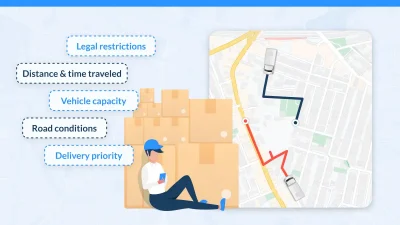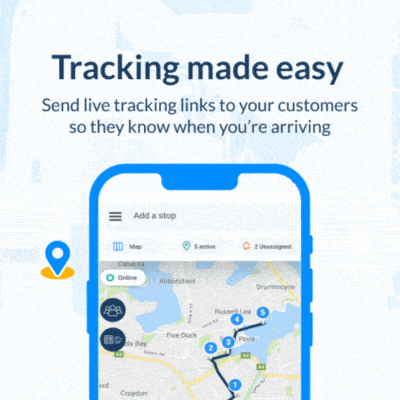Managing a fleet of vehicles may be difficult and complex for small business owners. Implementing fleet management best practices for small business owners is crucial to ensuring efficacy, cost-effectiveness, and regulatory compliance.
We will discuss fleet management best practices for small business owners in this post, along with useful advice and tactics to help with efficiency, safety, and production. These best practices can help you optimize your fleet operations and advance your business, whether you manage a small fleet of work cars or a few delivery vans.
I. Establishing a Fleet Management Plan
Fleet management best practices for small business owners must start with establishing a fleet management plan. A well-planned fleet management strategy provides small business owners with a road map for efficiently managing their fleet of cars. The essential elements of a thorough fleet management plan are as follows:
Choosing fleet goals and objectives
The initial stage of fleet management planning involves stating the fleet’s aims and objectives in plain terms. It can be strengthening customer service, cutting expenses, increasing operational efficiency, or hitting sustainability goals. Aligning fleet operations with overarching company objectives is made easier by defining precise, quantifiable targets.
Deciding on the right number and mix of vehicles
The ideal fleet size and the types of vehicles to include in the fleet must be carefully considered in light of the expectations and requirements of the business. To determine the correct fleet size and vehicle types for their business needs without incurring additional costs, small business owners should take into account certain aspects, including the kind of operations, area coverage, cargo capacity, and payload requirements.
Creating fleet policies and procedures
Standardizing methods and ensuring consistency can be achieved by establishing explicit rules and procedures for fleet operations. The use of vehicles, repair and maintenance, fueling, safety rules, driving behavior, and adherence to local laws and regulations are all covered by fleet policies. Fleet operations are carried out in a structured and legal manner when policies and procedures are well specified.
Making a financial management strategy and budget
Costs associated with fleet operations include those for vehicle purchase, maintenance, fuel, insurance, permits, and taxes. Small business owners should create a budget that takes into consideration all of these expenses and provide sufficient funds to successfully manage fleet operations. A financial management plan assists with budgeting, cost control, and spending optimization.
Fleet management software implementation: Fleet management software offers a consolidated platform for effectively managing fleet operations. It can automate processes including driver management, compliance reporting, fuel management, vehicle tracking, and maintenance scheduling. To streamline fleet operations and boost overall productivity, small business owners should invest in fleet management software that fits their demands and budget.
II. Purchase and upkeep of the fleet
To operate effectively and last for a long period, a fleet must be purchased and preserved in good shape. The following are examples of good fleet acquisition and maintenance strategies for small business owners:
Pick the proper vehicles
When choosing vehicles for their fleet, small business owners should pay close attention to their operational requirements and budget. The type of activities, payload capacity, fuel efficiency, safety features, and maintenance expenses must all be taken into account. One can select the vehicles that will best suit their business’s demands and budget while also offering the best performance and value by completing thorough research and analyzing the advantages and disadvantages of various vehicle alternatives.
Regular servicing and maintenance
To keep fleet vehicles in good condition, regular servicing and maintenance are essential. Establishing a preventative maintenance schedule for small businesses should include frequent tire rotations, oil changes, and other suggested routine maintenance procedures. Regular servicing and inspections aid in spotting any problems early, avoiding expensive breakdowns, and ensuring the fleet’s dependability and safety.
Maintain precise records of all maintenance actions and the costs associated with them in order to manage your fleet effectively. Small business owners ought to set up a system for monitoring and documenting all maintenance tasks, such as replacements, repairs, and inspections. This aids in finding trends, examining expenditures, and reaching wise fleet maintenance decisions. Additionally, it aids in guarantee and regulatory compliance.
Preventive maintenance schedules should be put in place. This proactive approach to fleet maintenance can help to increase the lifespan of fleet vehicles and decrease unforeseen breakdowns. Small business owners should create a preventive maintenance schedule based on industry best practices and manufacturer suggestions. Regular checks, service, and maintenance can help find and fix any faults before they grow into bigger difficulties, thus saving time and money.
Manage fuel consumption and costs
Managing fuel consumption and costs is essential for keeping costs under control because fuel represents a sizable expense for fleet operations. Small business owners should put into practice fuel management techniques including tracking gasoline usage, modifying routes, cutting down on idle time, and using fuel cards or other tools to track and manage fuel costs. Fuel expenses can be decreased and fleet efficiency can be increased by routinely examining data on fuel consumption and identifying areas for improvement.

III. Driver Administration
It is impossible to emphasize the importance of drivers in fleet management. For fleet operations to be effective and safe, drivers must be properly trained. The following are some effective practices for managing drivers for small business owners:
Employ experienced drivers
A dependable and effective fleet can be built by first hiring qualified drivers. Small business owners should establish a thorough recruiting procedure that involves checking potential drivers’ credentials, experience, and driving history. To make sure that drivers have a clear driving record and are qualified to operate the fleet’s type of vehicles, background checks and reference checks might be conducted.
Provide thorough training and onboarding
Ensuring that drivers are familiar with corporate regulations, safe driving techniques, and fleet procedures requires proper training and onboarding. New drivers should receive thorough training from small company owners, including instruction on the road, defensive driving tactics, vehicle inspection procedures, and emergency protocols. Maintaining safe driving practices and keeping drivers informed of the most recent laws and industry best practices can both be accomplished through regular refresher training sessions.
Implement safe driving policies and procedures
Reducing risks and ensuring driver safety require clear and comprehensive safe driving rules and procedures, which must be established. Small company owners ought to create and disseminate a set of policies and procedures that spell out expected driving behaviors, such as speed limits, seat belt use, distracted driving, and drug/alcohol policies. Establishing a culture of safety within the fleet can be facilitated by routinely examining and enforcing these standards.
Monitor driver behavior and performance
Monitoring driver behavior and performance is crucial for spotting and resolving any possible problems that can compromise fleet productivity and safety. Small business owners ought to use fleet management software or telematics to monitor driver behavior like idling, hard braking, and speeding. This information can shed light on how well drivers perform and point out areas for development. Driver behavior can be improved and the risk of accidents or infractions can be decreased by giving drivers feedback and coaching based on performance data.
Manage driver schedules and routes
Fleet operations can be significantly impacted by effective driver scheduling and routing. Establishing efficient scheduling and routing procedures that limit idle time, save fuel consumption, and optimize routes for on-time deliveries or repair calls is a good idea for small business owners. Route planning tools and fleet management software can be used to optimize driver schedules and routes, cut down on wasteful miles, and boost fleet productivity.
Make sure drivers follow corporate policies and rules
It’s important for drivers to follow company policies as well as local traffic laws and rules. Owners of small businesses should set up specific rules and criteria for drivers, then communicate and remind them frequently. This includes following business policies for vehicle usage and inspections, adhering to vehicle maintenance schedules, filing correct and timely reports, and abiding with local laws and ordinances regarding service hours, licenses, and permits.
IV. Telematics and Fleet Tracking
Small business owners can gain important insights into their fleet operations by using GPS tracking and telematics technology in fleet management. The following are some best practices for using telematics and fleet tracking:
Track the location, speed, and route information of the vehicle
Small business owners can use GPS tracking to track the location and speed of their fleet cars as well as to analyze route information. This data can give fleet managers visibility into their operations, enabling them to monitor vehicle movements, confirm that drivers are traveling the routes they have been given, and spot any deviations or unlawful use of vehicles. The ability to track deliveries or service calls in real-time and provide precise ETA (Estimated Time of Arrival) updates can help improve customer communication.
Analyze telematics data for improved fleet performance
By examining telematics data, which contains details on driver behavior, fuel use, and vehicle issues, fleet performance can be improved. Small business owners can utilize this data to discover areas that require improvement, such as boosting fuel efficiency, cutting maintenance expenses, and spotting potential safety issues. Analyzing telematics data can also help you find underused vehicles or routes, increase fleet efficiency, and create savings.
Optimize route planning and dispatching
Route planning and dispatching can be made more efficient with the use of fleet tracking and telematics. Small business owners can use route data analysis to find the most effective routes, cutting down on wasted miles and fuel use. Real-time tracking can also assist with dynamic rerouting of vehicles in the event of unforeseen events like traffic jams or road closures. Route planning and dispatching that is optimized can lead to a fleet that operates more efficiently, timely deliveries or service calls, and happier customers.
Enhance driver safety
Enhance driver safety by identifying risky behaviors and taking corrective action. Telematics data can reveal insights into driving behavior, such as abrupt braking, speeding, and idling. Using driver scorecards based on telematics data can encourage safe driving behaviors and give drivers constructive criticism for improvement. Increasing driver safety can lower the likelihood of collisions, infractions, and related expenses while also encouraging a culture of safety throughout the fleet.
Utilize fleet management software
Fleet management software with GPS tracking and telematics capabilities can be implemented to streamline fleet operations and offer useful insights. Depending on their unique requirements and financial constraints, small business owners can select from a vast array of fleet management software options on the market. By automating processes like vehicle tracking, route planning, maintenance scheduling, and driver performance monitoring, fleet management software can help increase fleet efficiency and save costs.

V. Compliance with Regulations
Small business owners need to follow local, state, and federal regulations in order to stay clear of fines and penalties linked to fleet operations. This includes managing fleet documentation, permits, and licenses, ensuring fleet vehicles are insured appropriately, doing regular vehicle inspections, and being proactive in addressing infractions and fines. Upholding complete compliance and being current with new regulations are essential for a fleet operation to be successful.
Owners of small businesses should set up systems and procedures to guarantee adherence to all relevant laws. This may entail keeping current records of vehicle registrations, inspections, and permits; verifying that drivers hold the necessary permits and licenses; and keeping enough insurance coverage for all fleet vehicles, among other things. To make sure fleet cars are compliant with legal standards, routine vehicle inspections can assist discover and address any maintenance or safety issues.
Small business owners should guarantee compliance with labor laws and fleet operations requirements in addition to vehicle-related laws and regulations. In order to prevent any legal and financial hazards, this may entail following rules for the number of hours that drivers can work, keeping an eye on and managing driver qualification files, and taking prompt action to handle any infractions or fines.
VI Monitoring and Reporting of Performance
For the purpose of identifying areas for improvement and improving fleet operations, it is essential to compare fleet performance to predetermined targets. Small business owners should create performance measures and Key Performance Indicators (KPIs) that are in line with their corporate objectives, evaluate fleet data, produce reports, and carry out routine fleet audits and reviews.
Small business owners can detect patterns, follow developments, and make data-driven decisions to optimize fleet operations with the use of performance monitoring and reporting. Analyzing gasoline consumption statistics, for instance, can show regions where fuel efficiency can be improved, while reviewing maintenance records can show places where maintenance expenses can be minimized. Insights into driver behavior, vehicle utilization, and fleet performance can be gained by routine fleet evaluations and audits, allowing for improvements.
VII. Performance Monitoring and Reporting
It’s crucial to evaluate fleet performance against set goals in order to pinpoint problem areas and enhance fleet operations. Owners of small businesses should develop performance metrics and Key Performance Indicators (KPIs) that are consistent with their corporate goals, analyze fleet data, produce reports, and conduct routine fleet audits and reviews.
Determining the ideal time to replace a fleet of aging or high-maintenance vehicles entails establishing a fleet replacement cycle. This may depend on elements including miles, age, repair expenses, and general performance. Small business owners can prepare their budgets and plan for replacement costs by choosing the best vehicle lifecycle and depreciation.
Responsible vehicle fleet management requires the implementation of appropriate disposal processes for retired vehicles. This might entail leasing, selling, or exchanging retired automobiles for new ones. To secure the company and customer information, small business owners should also make sure that decommissioned vehicles are properly de-identified and that any sensitive data is erased.
Responsible fleet management requires the implementation of appropriate disposal processes for retired vehicles. This might entail leasing, selling, or exchanging retired automobiles for new ones. To secure the company and customer information, small business owners should also make sure that decommissioned vehicles are properly de-identified and that any sensitive data is erased.
VIII. Ongoing Development
Proper fleet management is a continual activity that calls for constant development. Small business owners should welcome driver and employee feedback and suggestions, regularly review and update fleet management policies and procedures, keep up with industry trends and best practices, embrace technological advancements for better fleet management, and learn from past failures to correct course for future success.
Feedback from drivers and staff members can offer insightful information about fleet operations and point out areas for improvement. Fleet operations can be made more efficient and in line with organizational objectives by updating fleet management rules and practices in response to feedback, market developments, and best practices. Adopting modern technologies like telematics, fleet management software, and other tools might open up new possibilities for increasing fleet performance and efficiency.

Locate2u: Fleet management best practices for small business owners
Now having gone through fleet management best practices for small business owners, let’s get into Locate2u!
Locate2u is the perfect tool that a fleet manager can employee to gain full visibility of vehicles and assets with real-time tracking, optimizing fleet operations and reducing operating costs.
This fleet tracking software is perfect for businesses of all sizes. No matter if you have a small fleet of 4 vehicles or a large fleet of 1,000+ vehicles. You can access Locate2u from any location because it is a cloud-based service.
Click here to learn more about how Locate2u can help manage your fleet operations.













